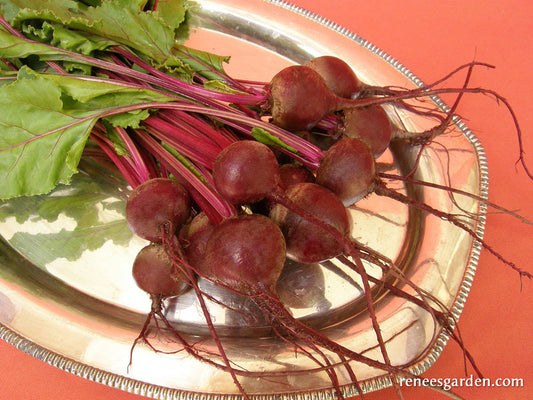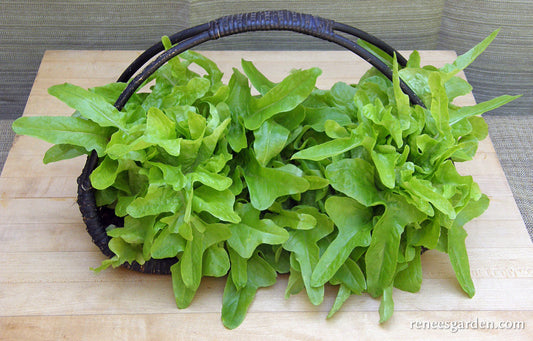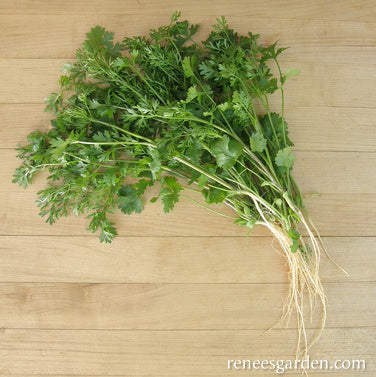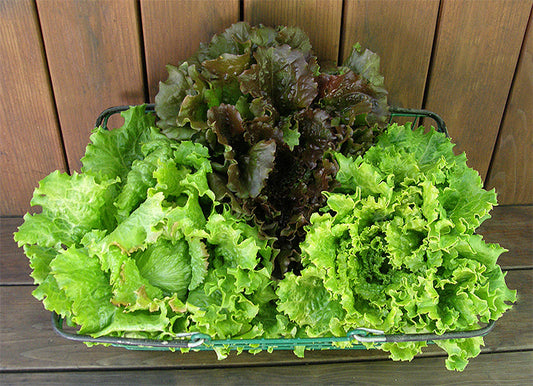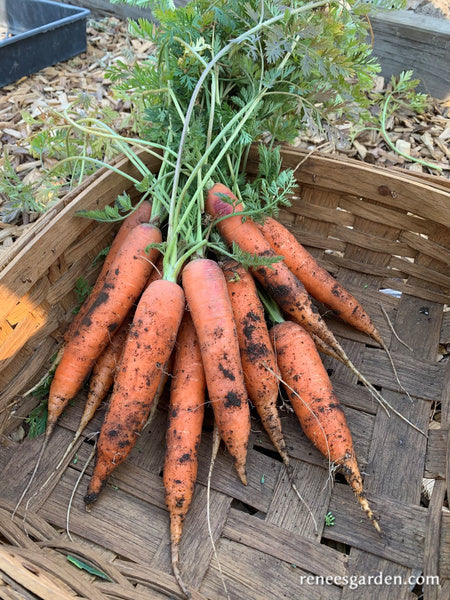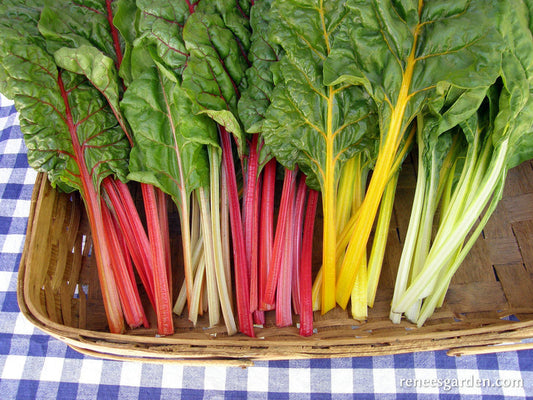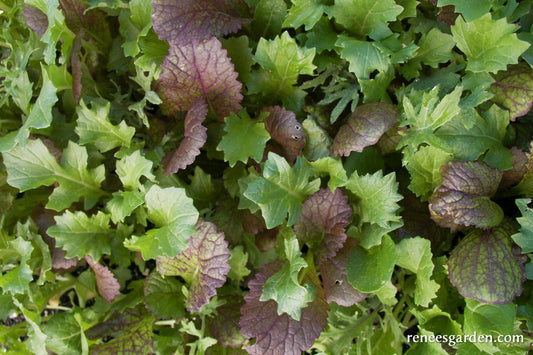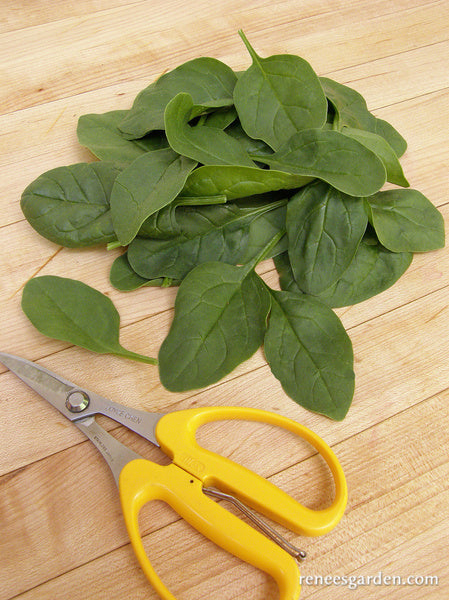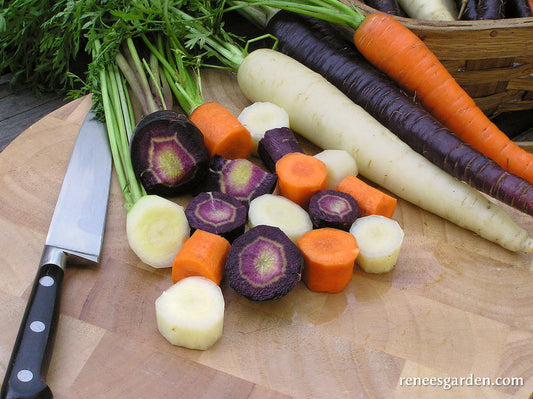Cool Weather Vegetables and Herbs
Easy to grow, highly nutritious and great tasting, these favorite early spring vegetables love cool weather and are the first varieties you can direct sow in the garden. If you live in colder climates, sow as soon as the danger of frost has passed. Fast-growing for earliest harvests, you'll find complete planting instructions on every packet and on our website.
-
'White Lisbon Bunching' Scallion/Cebolletas - Spanish/English
Perfect “green onions” or scallions for salads with mild flavor and crisp texture. Fast growing and productive over a long season. Not affected by day length.Regular price $2.19Sale price $2.19Unit price / per -
Gourmet Mesclun Salad Asian Baby Leaf
START SEEDS OUTDOORS
In cool early spring weather, sow seeds in finely worked soil in full sun. Shake seeds from the palm of your hand, broadcasting them about 1/2 inch apart over the entire seedbed or in wide rows, and cover lightly and evenly with 1/4 inch of fine soil. Firm soil gently and water with a fine spray.Keep seedbed evenly moist. Make small successive sowings until summer weather turns hot for a constant supply. Plant again in late summer for fall harvesting.
GROWING NOTES
This mix will thrive in mild weather with consistent moisture. To extend the sowing season into hot weather, sow in light shade or erect a canopy of loosely woven shade cloth over the bed. Birds are often attracted to tender young seedlings, so protect them if necessary.
HARVEST AND USE
To harvest by the “cut and come again” method, wait until plants are 4 to 6 inches tall. Cut as much as you need, using scissors to shear off a patch of leaves about 1 to 2 inches above the soil level. Water well and fertilize lightly and plants will regrow for several more cuttings. Dress with a simple vinaigrette to enjoy the sweet flavor and juicy texture of these delicate young leaves at their best. For this Asian mix, try using rice vinegar and a touch of soy sauce and garlic in your vinaigrette.
Regular price $3.39Sale price $3.39Unit price / per -
French Baby Carrots Babette
START SEEDS OUTDOORS
In spring once danger of hard frost is past, sow seeds in full sun in finely worked, fertile soil. Sow 1/4 inch deep and 1/2 inch apart in rows 8 inches apart, or broadcast thinly in beds and cover lightly. Keep seedbed evenly moist as carrots can be slow to germinate, emerging over 10 to 20 days.
If first sowing comes up unevenly, replant right away as seedlings catch up quickly. Be sure to thin young carrots several times so seedlings are about 2 inches apart and have room to size up.
GROWING NOTES
Carrots like well worked soil and need consistent moisture to grow well. If your soil tends to dry out, cover seedbed with floating row cover to help retain moisture during the germination period and water right through it. Keep carrots well watered and thinned. For a late season crop, sow again 3 months before first expected frost.
HARVEST AND USE
Let these baby carrots color up to orange before harvesting for best flavor. Pull as babies or let fully size up. Sauté or steam just until tender crisp and serve with a squeeze of fresh lemon or lime juice, sweet butter and fresh dill; or try buttered and glazed with a little maple syrup or honey.
Regular price $4.99Sale price $4.99Unit price / per -
Dutch Beets Baby Ball
START SEEDS OUTDOORS
In early spring when danger of hard frost is over, sow seeds in well-worked, fertile soil in full sun. Sow seeds 1 inch apart and 1/2 inch deep in rows 8 inches apart, or broadcast thinly for bed planting. Firm soil well over these irregularly shaped seeds to ensure good germination. If first sowing germinates unevenly, plant more seed in the rows as seedlings will catch up fast. Carefully thin when seedlings are large enough to handle to 3 to 4 inches apart so roots have room to grow and mature.
GROWING NOTES
For tender, best quality beets, sow seeds before midsummer heat and again in early fall at least 10 weeks before fall frosts. Keep soil evenly moist throughout the growing season. Be sure to thin beet seedlings carefully several times as they grow best when given enough room.
HARVEST AND USE
Harvest baby beets at 1 to 1 1/2 inches in diameter, or let some mature into full-sized beets. Briefly steam the tender-sweet tops for tasty greens. Freshly picked baby beets will cook very quickly; just steam, then peel and serve them with a little sweet butter and a sprinkle of chopped parsley or fresh dill leaf. Or try your own pickled baby beets!
Regular price $3.99Sale price $3.99Unit price / per -
Lawn & Patio Baby Beet "Little Queen"
Round Little Queen beets have a smooth buttery texture & delicious flavor. Harvest these smooth- skinned red beauties when just 1 to 1 1/2 in. diameter to enjoy as tender sweet babies. Enjoy them steamed, roasted, in salads or pickled.Regular price $2.29Sale price $2.29Unit price / per -
Heirloom Lettuce Baby Oakleaf
START SEEDS OUTDOORS
In cool spring weather, start seeds in full sun. Sow seeds 1/4 nch deep and 1 inch apart in fertile, well-drained soil. When seedlings are several inches tall, thin to a final spacing of 4-5 inches apart. Extra seedlings can easily be transplanted elsewhere.
Container Spacing: Grow 3 plants in an 8 inch pot, or 7 to 8 plants in a 12 to 15 inch diameter container.
GROWING NOTES
Lettuce thrives in cool conditions with consistent moisture. Be sure to thin properly and keep evenly moist for sweet tasting, full heads. For a constant supply, make several sowings a few weeks apart until summer weather turns hot. Plant again in late summer for fall harvest. In hot weather, give lettuce some afternoon shade to extend harvest season and check water daily. Keep soil evenly moist and feed with liquid fertilizer every 2 weeks.
Consider transplanting lettuce seedlings around the edges of a big pot containing a young tomato or pepper plant. The lettuces will be ready to eat just as the bigger plant grows larger and needs the space.
HARVEST AND USE
Savor young thinnings in your first spring salads. Then harvest plants by cutting mature heads when they feel firm and well-filled out. Pull over-mature plants if they begin to elongate (“bolt”) in hot weather, as leaves turn bitter at this stage.
Regular price $3.39Sale price $3.39Unit price / per -
Vietnamese Heirloom Bac Lieu Cilantro
ANNUAL
Spring/summer/fall harvest
Can handle light frostsEASIEST TO START OUTDOORS
Vietnamese Cilantro doesn’t transplant well; plant seeds directly in the garden. For continuous harvests, start in early spring and make successive sowings every few weeks until summer heat comes on strong. Sow again in cooler fall weather, especially in mild winter areas. Sow seeds in well-drained fertile soil 1 to 2 in. apart in rows 8 in. apart in full sun. Cover 1/4 inch deep and firm soil over seeds. Keep evenly moist as seedlings emerge. Thin seedlings 3 to 4 in. apart before plants get crowded.
GROWING NOTES
Vietnamese cilantro leafs out and flowers quickly as plants mature; lushest, leafy growth is in cooler temperatures of spring and fall. Plants thrive when well watered and thinned early so they have room to grow. If hot weather arrives early, plant in a spot with morning sun and afternoon shade. The lacy flowers of these plants attract beneficial insects and pollinating bees.
HARVEST AND USE
Vietnamese cilantro produces rosettes of leaves low on plants with more finely cut, serrated leaves towards the top. Harvest & use entire plant, including stems, leaves & even young flowers. Traditionally, Vietnamese cilantro is offered on a plate in the center of the table, so diners can help themselves. This delicious edible garnish & flavoring tastes similar to a delicate regular cilantro, but with an additional delicious hint of citrus spice.Regular price $3.69Sale price $3.69Unit price / per -
Lawn & Patio Beet "Heirloom Detroit Dark Red"
You can count on this fine heirloom variety for rich flavored, red-fleshed round beets. Enjoy garden-fresh or use for canning, pickling or freezing. The abundant vitamin-rich leaves, striped with red, are delicious quickly braised or fresh in salads.Regular price $2.29Sale price $2.29Unit price / per -
Lawn & Patio Beet Cylindria Seeds
This old-fashioned, rich-flavored beet has long cylindrical roots especially good for uniform, even slicing. Grows up to 6 inches long and 2 inches in diameter with tasty tops for greens.Regular price $2.29Sale price $2.29Unit price / per -
Beet Early Wonder
Classic all-around variety. Ideal for nutritious, flavorful and tender beet greens. Plants also produce dark red beets for pickling, salads or cooking.Regular price $2.29Sale price $2.29Unit price / per -
Lettuce Bibb Dark Green
Compact butterhead type to 3 1/2 inches wide, perfect for individual salads. Smooth dark green outer leaves with creamy light yellow interiors have a delicate, sweet flavor and crunchy texture. Displays some tip burn resistance in hot weather.Regular price $1.99Sale price $1.99Unit price / perNew -
Bonus Pack Bloomsdale Longstanding Spinach
This classic variety is good-looking, great tasting and slow to bolt so you have more time to harvest its crispy leaves. Enjoy cooked or as a great addition to salads and sandwiches. Harvest in about 45 days.Regular price $7.89Sale price $7.89Unit price / per -
Crunchy Lettuce Trio Blush Batavians
START SEEDS OUTDOORS
In cool, early spring weather, start seeds in finely worked soil in full sun. Sow seeds 1/4 inch deep and 1 inch apart in rows 6 to 8 inches apart or broadcast thinly in beds and cover lightly. Tend carefully and keep evenly moist. Gradually thin seedlings to stand 10 to 12 inches apart to allow heads room to mature. Make several sowings a few weeks apart until summer weather turns hot for a constantly maturing supply. Plant again in late summer for fall harvesting.
GROWING NOTES
Lettuce thrives best in cool conditions with consistent moisture. Weed, water and thin carefully for best quality heads. If birds are attracted to young seedlings, cover them with floating row covers or netting.
HARVEST AND USE
Savor earliest thinnings in spring salads. Then harvest by cutting entire mature heads or picking outside leaves after plants are well established. To extend planting into hotter weather, sow new seeds in containers in light shade. Transplant seedlings into the garden, shading for a few days and harvest heads while still young. Tasty French Batavian lettuces form heavy rosettes of big crunchy leaves that tolerate both hot and cold weather well. Enjoy them with any kind of dressing from a simple vinaigrette to a rich, creamy Gorgonzola. Their crispy texture is also perfect in sandwiches or tacos.
Regular price $3.39Sale price $3.39Unit price / per -
Crispy French Carrots Bolero Nantes
START SEEDS OUTDOORS
In spring once danger of hard frost is past, sow seeds in full sun in finely-worked, fertile soil. Sow 1/4 inch deep and 1/2 inch apart in rows 8 inches apart, or broadcast thinly in beds and cover lightly. Keep seed bed evenly moist as carrots can be slow to germinate, emerging over 10 to 21 days. If first sowing comes up unevenly, replant right away as seedlings catch up quickly. Thin young carrots several times so seedlings are 2 to 3 inches apart and have room to size up.
GROWING NOTES
Carrots like well-worked soil and need consistent moisture to grow well. If your soil dries out fast, cover seedbed with floating row covers to help retain moisture during the germination period. Keep carrots well weeded throughout the growing season. Plant again 3 months before first expected fall frost for a late crop.
HARVEST AND USE
Let carrots color up to deep orange before harvesting for best sweet flavor. Eat fresh, juice, or lightly steam. Set off their flavor with fresh lemon or orange juice and a sprinkling of minced herbs. Or glaze with a little honey and ginger or cinnamon. Fresh mint leaves are a tasty, pretty garnish for fresh garden carrots.
Regular price $3.99Sale price $3.99Unit price / per -
Rainbow Chard Bright Lights
START SEEDS OUTDOORS
In early spring when danger of hard frost is over, sow seeds in well-worked, fertile soil in full sun. Sow seeds 1/2 inch deep and 1 inch apart in rows 10 inches apart, or broadcast thinly for bed planting. Firm soil well over these irregularly shaped seeds to ensure good germination. If first sowing germinates unevenly, plant more seed in the rows as seedlings catch up quickly. Thin to select colors beginning when seedlings are large enough to handle, using thinnings as early greens and salads. Final spacing should be 10 to 12 inches apart so chard plants have room to mature.
GROWING NOTES
Chard grows well in a wide range of conditions and can take some frost. In mild winter areas, it can be grown year round. Thin seedlings well as chard grows into large vase-shaped plants 2 feet tall.
HARVEST AND USE
Begin harvesting when plants are well established and have 6 to 8 stalks. Both the crunchy succulent stalks and leaves make great eating. Chop and steam or sauté greens with garlic and olive oil or season with fresh lemon juice or balsamic vinegar. Use like spinach in lasagna or minestrone soup. Try tasty chard leaves stuffed and poached in broth with a dash of olive oil and fresh lemon.
Regular price $4.99Sale price $4.99Unit price / per -
Signature Salads California Spicy Greens
START SEEDS OUTDOORS
In cool early spring weather, sow seeds in finely worked soil in full sun. Shake seeds from the palm of your hand, broadcasting them about 1/2 to 1 inch apart over the entire seedbed or in wide rows, and cover lightly and evenly with 1/4inch of fine soil. Firm soil gently and water in with a fine spray. Keep seedbed evenly moist. Make small successive sowings until summer weather turns hot for a constant supply. Plant again in late summer for fall harvesting.
GROWING NOTES
These zesty flavored salad greens taste best given consistent moisture and mild weather. To extend the growing season into hot weather, sow in light shade or erect a canopy of loosely woven shade cloth over the bed and water regularly. Birds are often attracted to tender young seedlings, so protect them if necessary.
HARVEST AND USE
To harvest by the “cut and come again” method, wait until plants are 3 or 4 inches tall. Cut as much as you need, using scissors to shear off a patch of leaves 1 to 2 inches above the soil level. Water well and fertilize lightly and plants will regrow for several more cuttings. Mix these piquant baby greens with lettuces and fragrant herbs in proportions you prefer.
Regular price $3.39Sale price $3.39Unit price / per -
Lawn & Patio Carrot Chantenay Red Cored Seeds
A sturdy carrot for heavy soils. Short, thick carrots hold their sweet flavor, shape and crunch without becoming tough. Harvest early for ‘baby’ carrots.Regular price $2.29Sale price $2.29Unit price / per -
Lawn & Patio Carrot Little Finger Seeds
Deep orange Little Finger carrots develop sweet flavor early. Great to pull as ‘minis.’ Harvest at 3 inches for crunchy baby carrots or grow to maturity at 6-6 1/2 inches.Regular price $2.29Sale price $2.29Unit price / per -
Lawn & Patio Carrot Tendersweet Seeds
One of the sweetest bunching carrots you can grow. Long slender carrots grow to about 8-10 inches long. Deep orange roots are crisp, sweet and almost coreless.Regular price $2.29Sale price $2.29Unit price / per -
Baby Leaf Spinach Catalina
TO START OUTDOORS
In early spring when danger of hard frost is over, sow seeds in well-worked fertile soil in full sun. Space seeds 1 inch apart in rows 8 to 10 inches apart, or broadcast thinly for bed planting. Firm soil well over seeds to ensure good germination. If first sowing germinates unevenly, plant more seed as seedlings will catch up fast. Sow again in late summer.GROWING NOTES
Spinach is most productive in cool weather. Grow in cool spring conditions and sow again in late summer for a productive fall crop. After seedlings reach 2 to 3 inches tall, thin out every other plant (and enjoy in early salads) and keep thinning in this fashion until plants are spaced 5 or 6 inches apart.HARVEST AND USE
Either harvest individual outside leaves from well-established plants and let regrow, or harvest entire plants. Keep spinach plants well watered and weeded and fertilize these heavy feeders several times as they leaf out and especially after harvesting outside leaves. Combine well-washed and dried leaves with your favorite garlicky salad dressing; spinach pairs well with hearty dressings like the traditional hot bacon dressing. Good spinach salad additions include thinly sliced sweet red onions, sliced radishes, thin wedges of red apple or orange segments, toasted nutmeats, chopped scallions, crispy bacon bits, hard-cooked egg quarters and finely grated hard cheese.
Regular price $3.99Sale price $3.99Unit price / per -
Bonus Pack Cherry Belle Radish
Bolt-resistant, fast-growing Cherry Belle radishes taste great and maintain their crispy white interiors longer in the garden. These crunchy round beauties are ready to harvest in just 25 days.Regular price $7.89Sale price $7.89Unit price / per -
Heirloom Cilantro
EASIEST TO START OUTDOORS
In early spring, sow Cilantro seed directly into well-drained fertile soil 1 to 2 inches apart in rows 8 inches apart in full sun. Cover 1/2 inch deep and firm soil over seeds. Keep seed bed evenly moist as seedlings emerge over 10 to 20 days. Make new sowings every few weeks until mid summer for continuous harvests of fresh leaves.
THIN OR TRANSPLANT
Cilantro doesn’t transplant well; we advise direct garden sowing. Thin seedlings 3 to 4 inches apart before plants get crowded.
GROWING NOTES
Cilantro plants flower, then set seed quickly as plants mature. Lushest, leafy growth takes place in cooler weather; plant early and throughout cool spring weather and sow again in fall, particularly in mild winter areas. To have a constant supply of fresh leaves, sow every 2 to 3 weeks through early summer. Keep cilantro at its leafy stage longer by keeping plants well watered and being careful to thin seedlings early. Let some of the lacy flowers form to attract beneficial insects and pollinating bees. The fragrant round seeds are called coriander, an aromatic spice used in baking.
Regular price $4.89Sale price $4.89Unit price / per -
Lawn & Patio Cilantro Slow Bolt
Improved variety that’s slower to bolt in warm weather for a longer harvest time. Use both seeds and leaves to add distinctive flavor to a wide variety of dishes. Essential for Asian and Tex-Mex cooking.Regular price $7.89Sale price $7.89Unit price / per -
Tricolor Carrots Circus Circus
START SEEDS OUTDOORS
In spring once danger of hard frost is past, sow seeds in full sun in finely worked, fertile soil. Sow 1/4 inch deep and 1/2 inch apart in rows 8 inches apart, or broadcast thinly in beds and cover lightly. Keep seedbed evenly moist as carrots can be slow to germinate, emerging over 10 to 20 days.
If first sowing comes up unevenly, replant right away as seedlings catch up quickly. Be sure to thin young carrots several times so seedlings are about 2 inches apart and have the room they need to size up.
GROWING NOTES
Carrots like well-worked soil and need consistent moisture to grow well. If your soil tends to dry out, cover seedbed with floating row cover to help retain moisture during the germination period and water right through it. Keep carrots well-watered and thinned. For a late season crop, sow again 3 months before first expected frost.
HARVEST AND USE
For best sweet flavor, let these pretty, different colored carrots size up and fully mature before harvesting. Enjoy these extra healthy carrots raw as snacks or grated into salads for great eye appeal. Sauté or steam just until tender crisp and serve with a little sweet butter and your favorite fresh chopped herb. Carrots go well with dill, tarragon, chives, cilantro or mint.
Regular price $3.99Sale price $3.99Unit price / per







